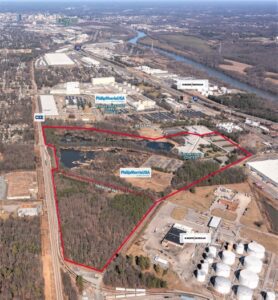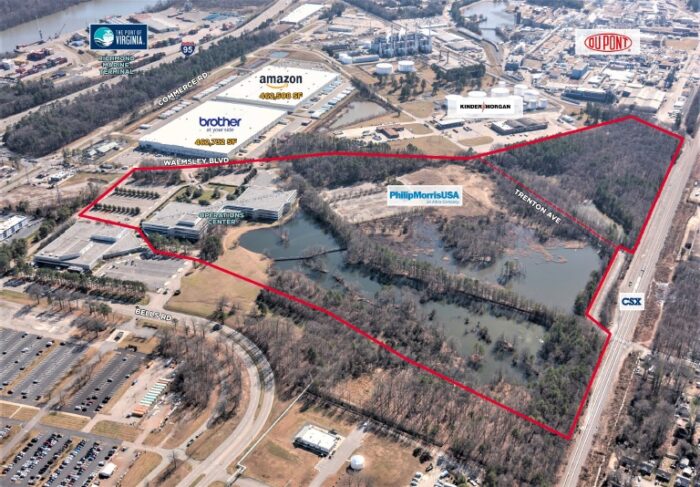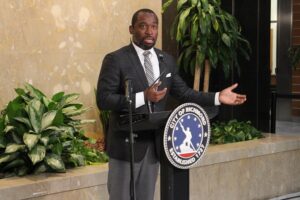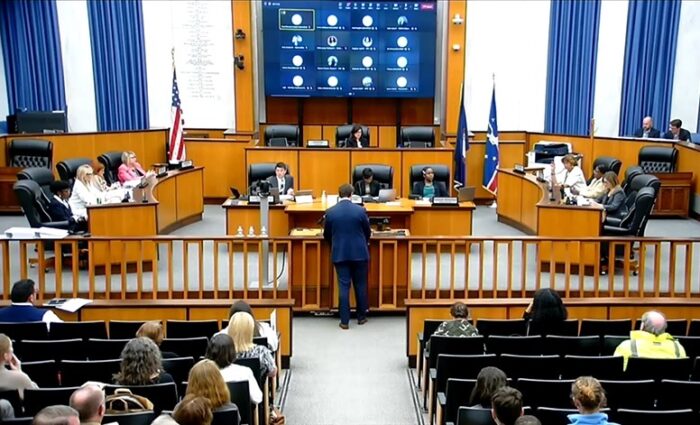In a five-hour meeting that saw several split decisions – and a resolution, for now, of the tax rate debate – City Council this week unanimously approved a multimillion-dollar purchase of the Southside site twice floated for a casino development.
Council OK’d spending $5.5 million to purchase 96 acres off Walmsley Boulevard for a new public park, an extension of Walmsley Boulevard from Commerce Road to Richmond Highway, and a roughly 45-acre economic development site.
The vote clears the way for the city to acquire and begin planning and potential marketing of the site, which administrators have said would prioritize workforce development and commercial and civic growth. The $5.5 million is part of $10 million that council budgeted this year to advance economic development in South Richmond in the wake of the casino plan that city voters twice rejected.
The city’s deal with property owner Philip Morris USA requires that it close on the purchase by Dec. 30. It also requires that the city demolish an existing building on the site by next December, administrators said at Tuesday’s meeting.

A northward view of the site, which is just south of the Philip Morris Manufacturing Center complex.
Councilmember Ellen Robertson asked for details on what could be developed on the property. But administrators noted that specific plans would result from potential development proposals for the 45-acre site, as well as designs and concepts for the park and connector road.
Those plans could be shaped by the city and the community, but only if the city controls the property, Chief Administrative Officer Lincoln Saunders said.
“We do not have a defined tenant or a defined plan. The goal would be to go out and see what are some of the best offers and best opportunities we can get. But if we don’t control the property, we don’t have any role to play in that potential development and to ensure that we get that type of development that we’re looking for,” he said.
The purchase is for Phillip Morris-owned property at 4700 Trenton Ave. and a portion of 2001 Walmsley Blvd. The site is just south of the Philip Morris Manufacturing Center complex along Commerce Road and Interstate 95.
In a news conference Wednesday, Mayor Levar Stoney said securing the site was desirable for attracting economic development and investment in the Southside.
Responding to questions from reporters, Stoney said: “It’s always better when the city gets to control the site for development, because someone can buy a piece of land and then, by right, they can do whatever they want with the land. At least we can provide some requirements on what we want to see and what the community wants to see as well.”
The city’s deal with Philip Morris, which listed the property for sale earlier this year, comes as parent company Altria Group is in talks about a potential sale of its Center for Research and Technology building downtown to Virginia Commonwealth University. Altria has said it would likely construct a new facility at the Philip Morris complex if a deal with VCU goes forward.
Asked Wednesday about that deal, Stoney acknowledged that a sale of the downtown building to VCU could remove more than $3 million in annual real estate tax revenue from the city’s tax rolls, because university-owned property is exempt from local taxes.
“There’s millions of dollars at stake if this were to be resorted to a nontaxable, tax-exempt piece of property, which means that the city would have to balance the budget by cutting services and expenditures. I have a problem with that,” he said.
Stoney also noted the impasse between the city and VCU Health over real estate tax payments stemming from the failed redevelopment of Richmond’s nearby Public Safety Building site, which the city owns and controls. He described the two scenarios as a “double whammy” for city residents.
“Since VCU refuses to live up to their obligation on the Public Safety Building, it’s problematic for me,” Stoney said. “On one hand, you decided to shortchange the residents of the city by not fulfilling your obligation on the Public Safety Building, and then on the other hand, you take the Altria Research Center off the tax rolls, costing the city multiple millions of dollars.”
Stoney added that the city supports VCU and credited it with leading “the rebirth” of the city. “However,” he said, “there needs to be a real discussion about their purchasing of tracts of land that don’t add to the tax rolls of the city. And it’s my hope that we can come to some resolution on the agreement that they made on the Public Safety Building.”
VCU Health has said it didn’t make the latest $2 million payment that was owed because of a directive from Virginia legislators included in the state budget that ordered the health system to find a way to stop the payments.
Before its regular meeting Tuesday, City Council met in a closed session to consult with legal counsel about the Public Safety Building site, which GRTC is considering for a mixed-use development that would include a permanent bus transfer station. No action was taken by council after the session.
Tax rate maintained, rebate approved
Also at Tuesday’s meeting, council voted 5-4 against Reva Trammell’s proposal to reduce the real estate tax rate by 4 cents, and then unanimously approved maintaining the rate at $1.20 per $100 of assessed value.
The decision brought to an end a monthslong debate over whether to adjust the rate in light of increased property assessments. Trammell had said the rate, unchanged since 2009, needed to be cut to help offset assessments that have outpaced many residents’ abilities to afford their rents and mortgages.
Council President Kristen Nye reiterated concerns over the timing, noting a plan to suspend assessments in an upcoming tax year to align the city’s assessment calendar with its budget-writing schedule. She also noted other tax relief programs and a one-time 4-cent rebate that was included with her proposal to maintain the tax rate and that were also approved by council Tuesday.
“This year, especially because we’re going to be holding the assessments steady for an upcoming year when we adjust the tax rate calendar, I just felt like it wasn’t the right year to reduce the rate,” Nye said.
“I think the package that the administration put together was thoughtfully targeted at our residents who need help the most, and I’m hopeful that the programs and the tweaks that we’ve made to the senior tax relief will provide relief.”
Joining Nye in voting against reducing the rate were Andreas Addison, Nicole Jones, Katherine Jordan and Cynthia Newbille. Jordan said reducing the rate could affect the city’s borrowing capacity and would be risky in light of pending federal changes.
“We’re going into a lot of unknowns,” Jordan said. “I appreciate and hear within my district as well the stress and the pressure that the increased assessments have put on people. The rebate is 4 cents, equivalent to the tax cut, without locking us into that tax cut when we have no idea what the next president’s going to do and what the implications are going to be on our budget and our funding.
“We just don’t know, so I’d rather not lock into that,” she said.
In other business, council approved reallocating $2 million in funds for the purchase of a building and warehouse at 2310 W. Cary St. and 2311 Herbert Hamlet Alley for a new pet adoption center for Richmond Animal Care & Control. The facility would supplement RACC’s current facility on Chamberlayne Avenue, which would be dedicated to nonadoption services.
The vote was 7-2, with Robertson and Stephanie Lynch opposing. Lynch and Robertson took issue with how the project was proposed and said it was taking priority over other needs in the city. “Yes, we need to invest in an animal shelter,” Lynch said, “… but budgeting is about prioritizing.”
Other councilmembers countered that the need would just get bigger and become more expensive over time. More than two dozen people spoke in support of the project in a public hearing.
In a five-hour meeting that saw several split decisions – and a resolution, for now, of the tax rate debate – City Council this week unanimously approved a multimillion-dollar purchase of the Southside site twice floated for a casino development.
Council OK’d spending $5.5 million to purchase 96 acres off Walmsley Boulevard for a new public park, an extension of Walmsley Boulevard from Commerce Road to Richmond Highway, and a roughly 45-acre economic development site.
The vote clears the way for the city to acquire and begin planning and potential marketing of the site, which administrators have said would prioritize workforce development and commercial and civic growth. The $5.5 million is part of $10 million that council budgeted this year to advance economic development in South Richmond in the wake of the casino plan that city voters twice rejected.
The city’s deal with property owner Philip Morris USA requires that it close on the purchase by Dec. 30. It also requires that the city demolish an existing building on the site by next December, administrators said at Tuesday’s meeting.

A northward view of the site, which is just south of the Philip Morris Manufacturing Center complex.
Councilmember Ellen Robertson asked for details on what could be developed on the property. But administrators noted that specific plans would result from potential development proposals for the 45-acre site, as well as designs and concepts for the park and connector road.
Those plans could be shaped by the city and the community, but only if the city controls the property, Chief Administrative Officer Lincoln Saunders said.
“We do not have a defined tenant or a defined plan. The goal would be to go out and see what are some of the best offers and best opportunities we can get. But if we don’t control the property, we don’t have any role to play in that potential development and to ensure that we get that type of development that we’re looking for,” he said.
The purchase is for Phillip Morris-owned property at 4700 Trenton Ave. and a portion of 2001 Walmsley Blvd. The site is just south of the Philip Morris Manufacturing Center complex along Commerce Road and Interstate 95.
In a news conference Wednesday, Mayor Levar Stoney said securing the site was desirable for attracting economic development and investment in the Southside.
Responding to questions from reporters, Stoney said: “It’s always better when the city gets to control the site for development, because someone can buy a piece of land and then, by right, they can do whatever they want with the land. At least we can provide some requirements on what we want to see and what the community wants to see as well.”
The city’s deal with Philip Morris, which listed the property for sale earlier this year, comes as parent company Altria Group is in talks about a potential sale of its Center for Research and Technology building downtown to Virginia Commonwealth University. Altria has said it would likely construct a new facility at the Philip Morris complex if a deal with VCU goes forward.
Asked Wednesday about that deal, Stoney acknowledged that a sale of the downtown building to VCU could remove more than $3 million in annual real estate tax revenue from the city’s tax rolls, because university-owned property is exempt from local taxes.
“There’s millions of dollars at stake if this were to be resorted to a nontaxable, tax-exempt piece of property, which means that the city would have to balance the budget by cutting services and expenditures. I have a problem with that,” he said.
Stoney also noted the impasse between the city and VCU Health over real estate tax payments stemming from the failed redevelopment of Richmond’s nearby Public Safety Building site, which the city owns and controls. He described the two scenarios as a “double whammy” for city residents.
“Since VCU refuses to live up to their obligation on the Public Safety Building, it’s problematic for me,” Stoney said. “On one hand, you decided to shortchange the residents of the city by not fulfilling your obligation on the Public Safety Building, and then on the other hand, you take the Altria Research Center off the tax rolls, costing the city multiple millions of dollars.”
Stoney added that the city supports VCU and credited it with leading “the rebirth” of the city. “However,” he said, “there needs to be a real discussion about their purchasing of tracts of land that don’t add to the tax rolls of the city. And it’s my hope that we can come to some resolution on the agreement that they made on the Public Safety Building.”
VCU Health has said it didn’t make the latest $2 million payment that was owed because of a directive from Virginia legislators included in the state budget that ordered the health system to find a way to stop the payments.
Before its regular meeting Tuesday, City Council met in a closed session to consult with legal counsel about the Public Safety Building site, which GRTC is considering for a mixed-use development that would include a permanent bus transfer station. No action was taken by council after the session.
Tax rate maintained, rebate approved
Also at Tuesday’s meeting, council voted 5-4 against Reva Trammell’s proposal to reduce the real estate tax rate by 4 cents, and then unanimously approved maintaining the rate at $1.20 per $100 of assessed value.
The decision brought to an end a monthslong debate over whether to adjust the rate in light of increased property assessments. Trammell had said the rate, unchanged since 2009, needed to be cut to help offset assessments that have outpaced many residents’ abilities to afford their rents and mortgages.
Council President Kristen Nye reiterated concerns over the timing, noting a plan to suspend assessments in an upcoming tax year to align the city’s assessment calendar with its budget-writing schedule. She also noted other tax relief programs and a one-time 4-cent rebate that was included with her proposal to maintain the tax rate and that were also approved by council Tuesday.
“This year, especially because we’re going to be holding the assessments steady for an upcoming year when we adjust the tax rate calendar, I just felt like it wasn’t the right year to reduce the rate,” Nye said.
“I think the package that the administration put together was thoughtfully targeted at our residents who need help the most, and I’m hopeful that the programs and the tweaks that we’ve made to the senior tax relief will provide relief.”
Joining Nye in voting against reducing the rate were Andreas Addison, Nicole Jones, Katherine Jordan and Cynthia Newbille. Jordan said reducing the rate could affect the city’s borrowing capacity and would be risky in light of pending federal changes.
“We’re going into a lot of unknowns,” Jordan said. “I appreciate and hear within my district as well the stress and the pressure that the increased assessments have put on people. The rebate is 4 cents, equivalent to the tax cut, without locking us into that tax cut when we have no idea what the next president’s going to do and what the implications are going to be on our budget and our funding.
“We just don’t know, so I’d rather not lock into that,” she said.
In other business, council approved reallocating $2 million in funds for the purchase of a building and warehouse at 2310 W. Cary St. and 2311 Herbert Hamlet Alley for a new pet adoption center for Richmond Animal Care & Control. The facility would supplement RACC’s current facility on Chamberlayne Avenue, which would be dedicated to nonadoption services.
The vote was 7-2, with Robertson and Stephanie Lynch opposing. Lynch and Robertson took issue with how the project was proposed and said it was taking priority over other needs in the city. “Yes, we need to invest in an animal shelter,” Lynch said, “… but budgeting is about prioritizing.”
Other councilmembers countered that the need would just get bigger and become more expensive over time. More than two dozen people spoke in support of the project in a public hearing.






The proposed extension of Walmsley Road makes sense but to align it with the right of way west, it appears to need to cross a site developed by Public Storage for mini-warehouses. Otherwise, the road ends at Richmond Highway. Are there plans to build it further to the west? The site aerial shows extensive lowlands to the north encompassing a good 40 acres and another pond impacting development on the balance of the 57acres. I hope there’s enough high and dry land to account for the price tag.
The observation of the extensive lowlands in that aerial image was one of my first thoughts too. And to anyone in the development business, you know that such areas can be defined well beyond the waters’ edge based on a valid wetland delineation.
The City buys 96 privately owned taxable acres and takes it off the tax rolls and then Mayor Stoney turns around and complains about VCU potentially buying a research lab and doing the same thing.
AND taxpayers pays for the demolition of an adjacent privately owned building on the lot next to it (not on the land we are acquiring) owned by Altria/PM?? We could afford to do this but (and if your old enough to remember 8 – 12 decimal place tax rates) we can’t afford to make the tax rate drop to say $1.194555. Funny back in the day the set the rate so that estimated income to the spending budget match estimated fund/savings deposits and we never had these $15-$20M surpluses that ratepayers get 25% of it back in rebates ever other… Read more »
In this case, it is apparently what the voters wanted. Clearly, rather than using the property to generate tax revenue, the voters rather spend tax money on green space far away from those very voters. Are you not looking forward to driving down I-95 to a non-riverside park, surrounded by heavy industry?
you mean like building a bike trail at $5Million per mile?
Exactly
Well, the voters in most of the other districts, anyway. The voters in that district voted for the casino … twice.
This place looks like it’s a lake or a swamp they should turn it into a city park in that I don’t think building over this place would be a good idea.
There’s a Virginia law that if assessments go up by 1%, they need to lower the rate. Can someone explain to me why they can decide not to lower the rate? From what I read in subsection B, I guess they can deem the extra money as “necessary.”
https://law.lis.virginia.gov/vacode/title58.1/chapter32/section58.1-3321/
They always advertise the roll back rate, publish, and schedule a vote at least 7 days after the notice is published and then VOTE every year against the roll back rate and for the current rate thus raising taxes.
The City is required to demolish the existing building by the end of next year. The City of Richmond should do the same with regard to the decaying Coliseum. The propeorty, in my opinion, would be more desirable for developers to step up to the plate.
Stoney closing the functional and useable Coliseum to push a development project tax payers would have to pay for should be part of his lasting legacy. Good riddance dude.
It’s debatable how functional it was. The maintenance cost challenged the revenue and the number of events it could attract in its condition was dwindling. It had no regular paying tenants, the same issue that Henrico faces in financing construction of the “Green City” arena.
when was the last time you had been in the coliseum? usable? As a red cross shelter in a disaster maybe. Functional? not as a building meant to host events.
Kim: Sorry, but the Coliseum has been functionally obsolete for years for multiple reasons. For example, you needed to bring equipment for concerts, or other events, up an elevator. Modern buildings don’t need elevators. There is also asbestos in the building. The building is also undersized for serious events. I could go on but I hope you get the idea.